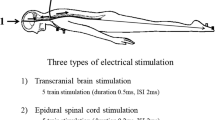Abstract.
Short-latency somatosensory evoked potentials (SSEPs) were measured before and after intermittent cervical traction therapy to serve as objective indicators of therapy effectiveness. The subjects were 29 patients with myelopathy, 23 with cervical radiculopathy, 28 with cervical sprain, and 26 healthy individuals. SSEPs were recorded by stimulating the median nerve, and the negative potentials elicited from the brachial plexus (N9), neck (N11, lcN13, ucN13), and somatosensory area (N18) were measured to determine interpeak latencies and then corrected latency. As to the changes in SSEPs following traction, the N11-lcN13 and lcN13-ucN13 interpeak latencies for patients with type I and II myelopathy decreased, and the severity of myelopathy was inversely related to the degree of decrease. The ucN13-N18 interpeak latency for some patients with severe myelopathy increased. The N9-N11 and N11-lcN13 interpeak latencies for patients with cervical radiculopathy decreased, and the ucN13-N18 for patients with cervical sprain accompanied by autonomic nervous symptoms also decreased. Traction therapy might improve conduction disturbance primarily by increasing the amount of blood flow from the nerve roots to the spinal parenchyma.
Similar content being viewed by others
Author information
Authors and Affiliations
Additional information
Received: April 16, 2001 / Accepted: November 12, 2001
About this article
Cite this article
Hattori, M., Shirai, Y. & Aoki, T. Research on the effectiveness of intermittent cervical traction therapy, using short-latency somatosensory evoked potentials. J Orthop Sci 7, 208–216 (2002). https://doi.org/10.1007/s007760200035
Published:
Issue Date:
DOI: https://doi.org/10.1007/s007760200035




